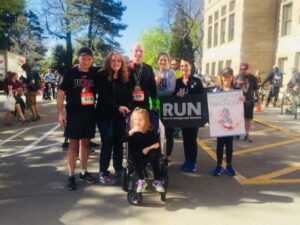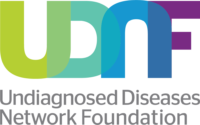19 Jul Inside Look into the UDN University of Utah Health Site: Interviews with Dr. Botto and Ashley Andrews
By Troy Evans | July 19, 2022
Continuing UDN PEER’s efforts to highlight those individuals making the UDN special, I had the honor of meeting with those who operate the Utah UDN site in May, 2022.
Dr. Lorenzo Botto (LB), MD, is the Principal Investigator of the Utah clinical site and professor of Pediatrics at the University of Utah School of Medicine. Dr. Botto shares with us the Penelope Program, which predates the UDN, and his care for the work of solving diagnostic mysteries. Ashley Andrews (AA) is a Utah UDN site coordinator and has been with Dr. Botto from the beginning of the Penelope Program through Utah’s current participation in the UDN. To learn more about the Penelope Program you can visit The Penelope Program.
Below are excerpts (lightly edited) from the interview.
What was your work like prior to the UDN?
LB: It was a work probably similar to many other clinicians. I’m a clinical and biochemical geneticist with an interest in training and also epidemiology and public health. I was running or helping to run a number of clinics here at the University of Utah. Also involved in a number of epidemiologic and public health studies to try and assess what’s going on population-wide with some of these conditions.
What was the process like of joining as a clinical site of the UDN?
LB: The UDN probably was the engine that made many things happen in the last few years. I’m specifically referring to the development of what we call the “Penelope undiagnosed and rare disease program.” We had heard about the UDN a few years back, during its first ‘version’. We were not part of that, but our leader in the department of pediatrics thought that a program such as this really addressed a critical need in the community. The community of people with undiagnosed and rare conditions wasn’t well served. Admittedly, current health care systems do quite well with common conditions – but not so well for people with rare or new conditions or with so called atypical presentations (basically, something that you don’t see often). There are reasons for this. It’s not because we don’t want to or that we do not have the expertise or knowledge. It’s typical process of diagnostic evaluation that just doesn’t work well in this context. As you know, the typical process is sequential — you see a primary care provider and if she or he doesn’t figure it out, you go to a specialist. If that does not work out you go to another specialist. You get hospitalized. And the cycles continues, sometimes for years, leading to preventable cost and pain and frustrations for everyone…… The process needs to change: let’s get things done promptly and efficiently — let’s get to that needle in the haystack as quickly as possible so that we can do a better job for care and management.
Through the Penelope program we built a community of likeminded clinicians and scientist — when the opportunity came to be part of the UDN we pounced on it and we were fortunate to be selected among the clinical sites.
AA: So I think he really took the model, the Penelope project and what we do. The infrastructure we had created. And then when he applied to the UDN we were essentially thinking about expanding it to include the adult population and other states in our area. The big step there was really engaging adult providers. One of the other things we feel like brought strength to become part of the UDN was the fact that we already had this program and with the definite goals of sustainability we wanted to see how we could bring what we were doing with Penelope to our UDN program. And how we could make that sustainable after the UDN funding.
As a specialist and principal investigator, what keeps you motivated while going through such a wide range of symptoms, ages, and participants in this rarest of the rare arena?
LB: I think a couple of things. One thing that we really like and many people like is the sense of community associated with this work. If somebody has, let’s call it a “named condition”, it’s easier to find the patient group, the family group, the Facebook group, the website that’s specific for that condition for that gene or for that presentation. When one is undiagnosed there is at times a sense of solitude and isolation that comes with not easily finding a community with whom to share the experience. But this is now changing. There are now strong and powerful communities of people with undiagnosed conditions. And that sense of community, which started out really with the families, has come now to encompass us as well. This community has a strong voice and really helps us, supports us, and empowers us to keep moving forward.
Another strong motivation is the ability to tackle difficult issues as a team. This comes through clearly when speaking with the other clinicians and others who work with us. It’s truly powerful and in many ways really beautiful to work together as a team. We learn from each other — I like to call this a learning community. As with many things in life, it is the challenge that brings out the best of people. And this is true for our clinicians and scientists. What comes to us through the UDN is not what they see every day in their normal clinics or labs. Every day we learn from each other through this experience.
This combination of being able to help families and well as being at the forefront of discovery and science is what makes such work a unique experience. When you add in the sense of community, being part of something larger than ourselves and partnering with families, then you are work with a sense of gratitude for being part of something special.
AA: It can be hard. Especially for the patients that we have followed for so long and keep searching and not finding an answer. I think what keeps us going is knowing that we are doing everything we can in that journey and that along the way we are ruling out a lot of things that it is not. Knowing that we really put everything into it we can, using all of the science we have right now and continuing to work with our teams to ask “what else can we do to elevate the next level of evaluation” gets us through. I think there is always an inherent hope in genetics because it is something we’re still learning about. New syndromes and new genes are found all the time and so there is always this piece of hope that even if you don’t have answers right now, there might be something coming up in the future.
You’ve been a long supporter of the entire rare disease community, and you have also been a long supporter of the patient lead groups. In 2019 you teamed up with NORD and RUN and participated in Running for Rare in the Boston Marathon. Have you always been a runner, Dr Botto?
LB: No! Actually, it’s an interesting story! It was the Penelope Program and the connection with undiagnosed conditions that led me on the road towards running and putting my first pair of running shoes on since high school. I went from couch to Salt Lake City half marathon representing RUN in 5 weeks. After surviving that, I just kept going, including running the Boston marathon in 2019 with NORD (with the indispensable encouragement of Paul Mazur), and now, in about 2 weeks, running my 10th marathon.
Do you have any final thoughts you would like to share with the rare disease community?
AA: I think the other really special thing about our program is Dr. Botto. As the lead, he is a very thoughtful and thorough person. I think he is the perfect person to lead this effort for us.
LB: First and foremost, this truly is a team effort. There is also much going on in the background with the goal of supporting and sustaining these efforts, including everything that PEER is doing to continue making the UDN a nationwide resource – not only to make the UDN survive, but also to make it grow into something larger and even better. There are many organizations out there, local as well as national, that share these same goals, and we have to thank those organizations, and you, for what the UDN is now and will be in the future. You (individual and families) have a much stronger voice than clinicians or academics to make things happen at the national level.
The second thing I have to say is that we feed off your hope and your strength. I really mean this. We are strengthened by the hope and the realism that you show in continuing this journey towards a diagnosis.
And here I’d like to spend a word of hope vs. hype. As you know, there is a danger with hype. Genetics has a way of generating hype. Some think, we found this gene and now we will have a cure! That’s not realistic in many cases. But hope is – finding a cause is a step forward. There is much more that needs to be done, but realistic hope, as opposed to hype that burns quickly and sometimes leaves little but ashes, is the fire that keeps all of us going. I like to use the the metaphor of the marathon — there are a lot of steps that need to be taken in order to move from discovery to actionable findings and then to treatment and cures. We learn every day from the community to balance hype with hope, to approach every new discovery with both feet on the ground knowing we are here for the long game — or pardon the pun, the long run.
Click here to watch my interview with Dr. Lorenzo Botto and Ashley Andrews from the UDN Utah Clinical Site.




